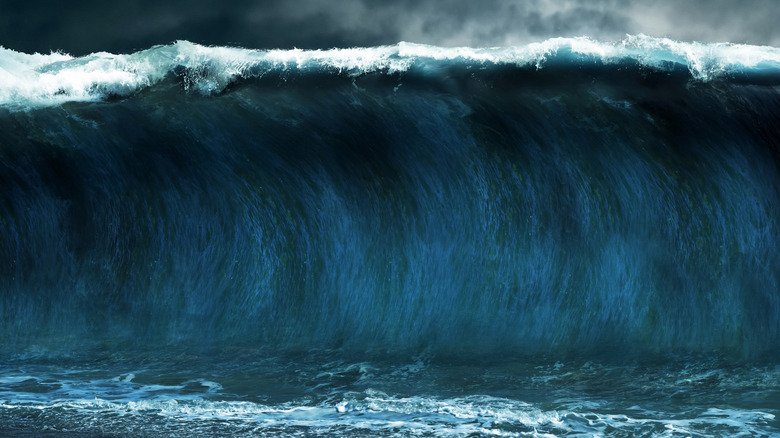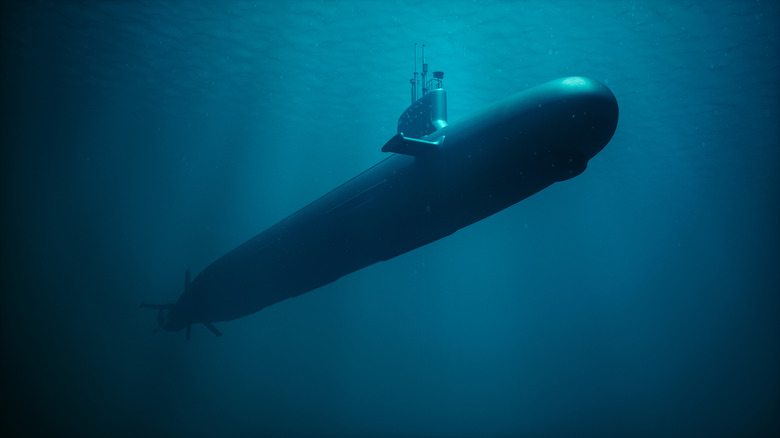Are Submarines Safe In A Tsunami? Here's What Would Happen
If you've ever wondered what the safest place is to be during a tsunami, your first thought is most likely high on a mountaintop somewhere. But what about the depths of the ocean, in the fortified walls of a submarine? At first glance it makes perfect sense — it's a steel fortress built to withstand the greatest pressures on Earth and travel inconspicuously below the chaos of the surface. But the truth is a little more complicated.
In the vast depths of the deep ocean, tsunamis are not the towering walls of water most people think they are. Out in the deep, it's a long, low pulse in the ocean, often less than a meter high, rendering it almost unnoticeable to ships as it slides underneath them. Submarines cruising hundreds of meters below are even less aware of them. The danger comes when all that energy runs into shallow coastal waters, causing the waves to slow down and grow into the destructive forces most people know.
Regardless of how deep military submarines can go, all modern submarines are capable of patrolling far deeper than the 50–150 meters , where tsunamis are at their most dangerous, meaning a sub will usually ride out the event with little more than a shift in pressure, but not always.
When depth isn't enough
While submarines have a host of engineering advantages to protect them against tsunamis at depths, it all becomes null and void at the surface. A wave like that can lift and throw thousands of tons of steel as if it were a tiny stick. Even if the hull were to stay intact somehow, it's most likely all the controls and electrical systems would be destroyed. Not even the biggest military submarines ever made could withstand it.
Shallow waters carry a different set of problems. Tsunamis churn the ocean in ways that aren't always visible from above, producing sudden, violent currents. The erratic change of currents and density can create internal waves that can rob a submarine of its buoyancy, sending it plunging as though it had dropped off a cliff.
Earthquakes can also trigger underwater landslides, turning whole slopes of the seabed into fast-moving clouds of rock and sediment. In those conditions, even a boat operating far below the surface isn't untouchable. On rare occasions like the 2004 Indian Ocean disaster, the power of the wave can reach much farther down than usual, putting even deep-diving vessels at risk.
The extreme limits
Researchers have imagined far worse scenarios, like whether a submarine can survive a nuclear attack, in a study on submarines as safe havens during major crises. Their models suggest that most subs could survive pressure waves from 200–400 meter-high swells if they stayed around 400 meters deep. But if the wave is on the scale of a skyscraper, which can only be created by an asteroid impact, survival is far from certain. While submarines are designed to withstand sudden, intense bursts of pressure from explosions and even nuclear blasts, energy moves through water in unpredictable ways. In some cases the destructive forces could be pushed deeper rather than dispersed across the water.
As with most things in life, there are exceptions, and here they come in the form of two titanium-hulled Russian submarines. The secretive vessels in question are the Komsomolets and Loshark, rumored to dive to depths of 1,250 and over 2,000 meters, respectively. At those depths, no tsunami could touch them. A submarine in an enclosed body of water, like the Mediterranean, would also likely avoid the brunt of an oceanic tsunami entirely. But for the majority of subs, survival comes down to where they are and how deep they can go.
In most cases, a submarine deep in the open ocean is far safer than anything on the surface when a tsunami hits. Still, "safer" isn't the same as safe. The ocean, after all, doesn't care how advanced your technology is — it will always have the final say.


